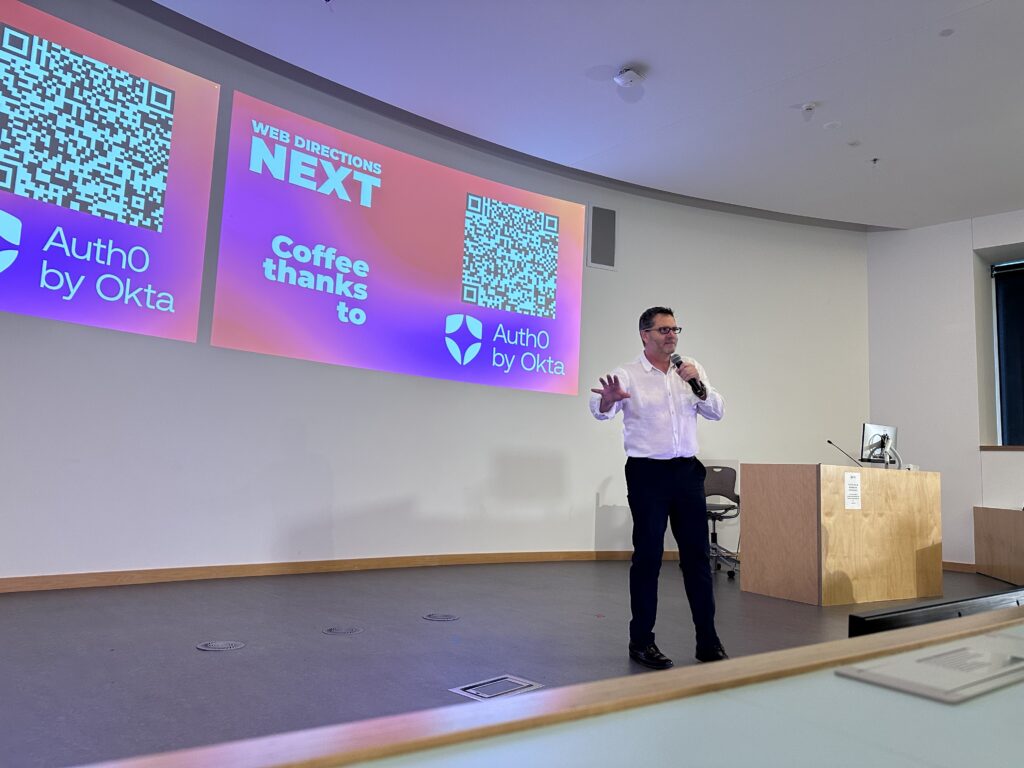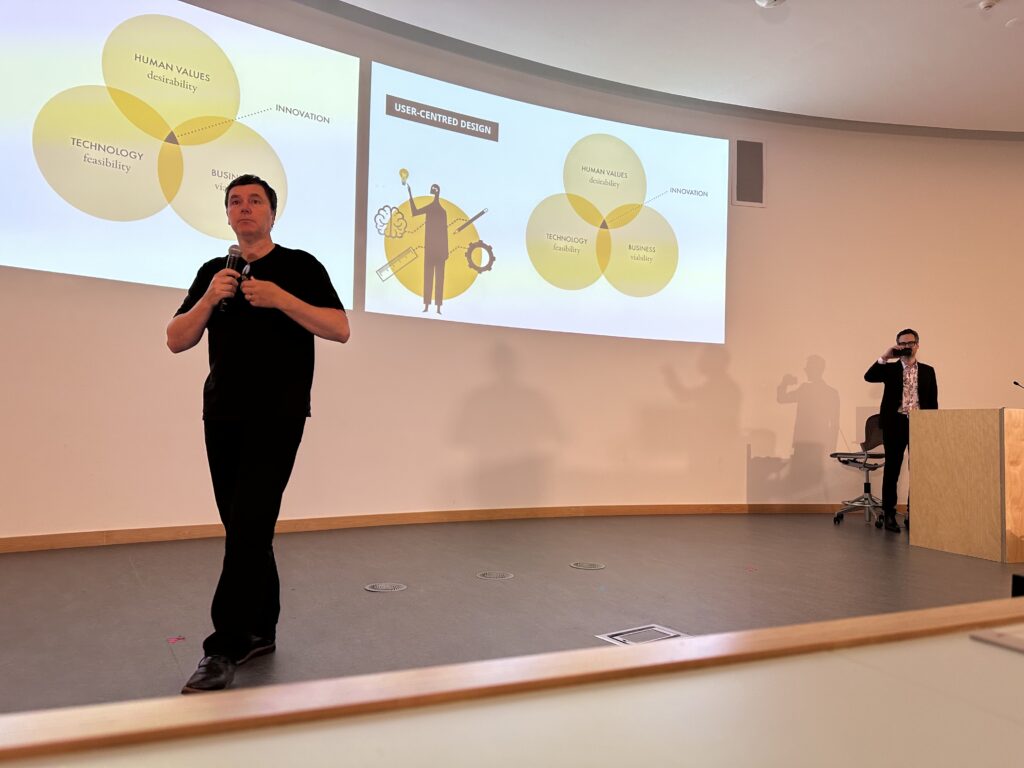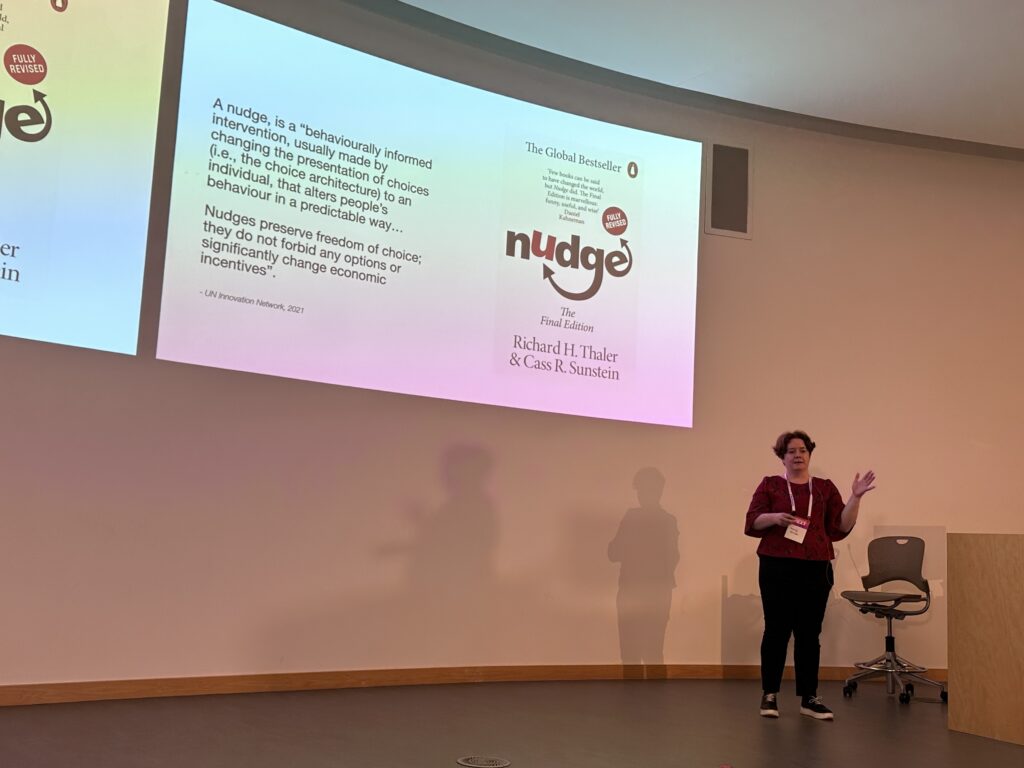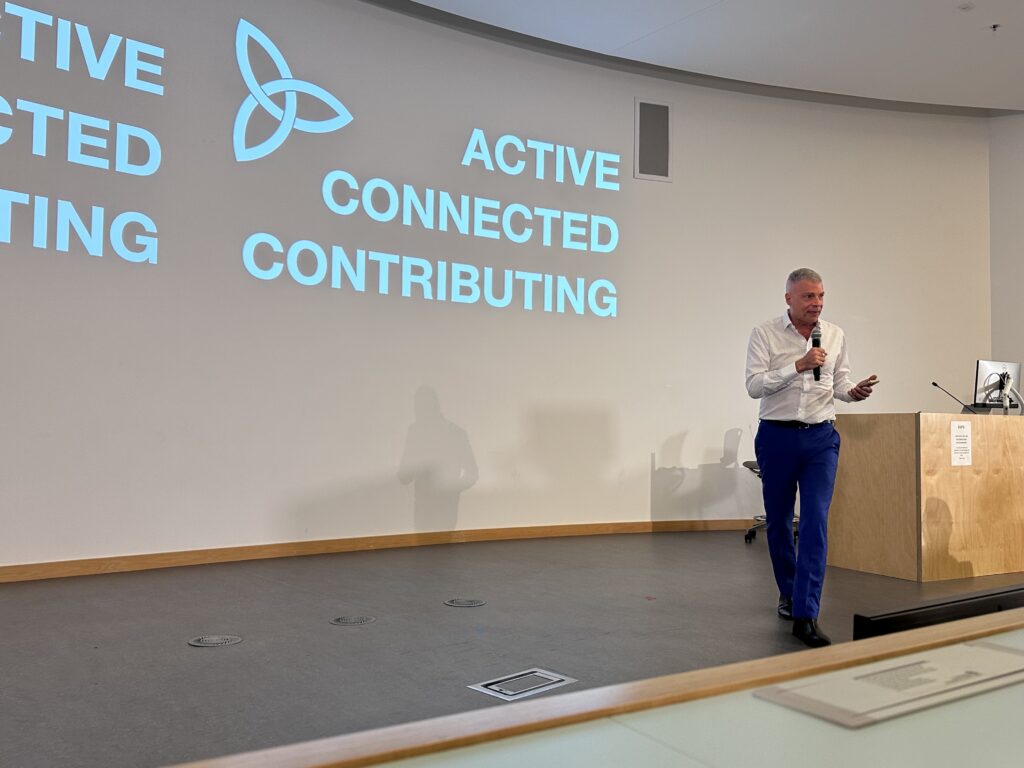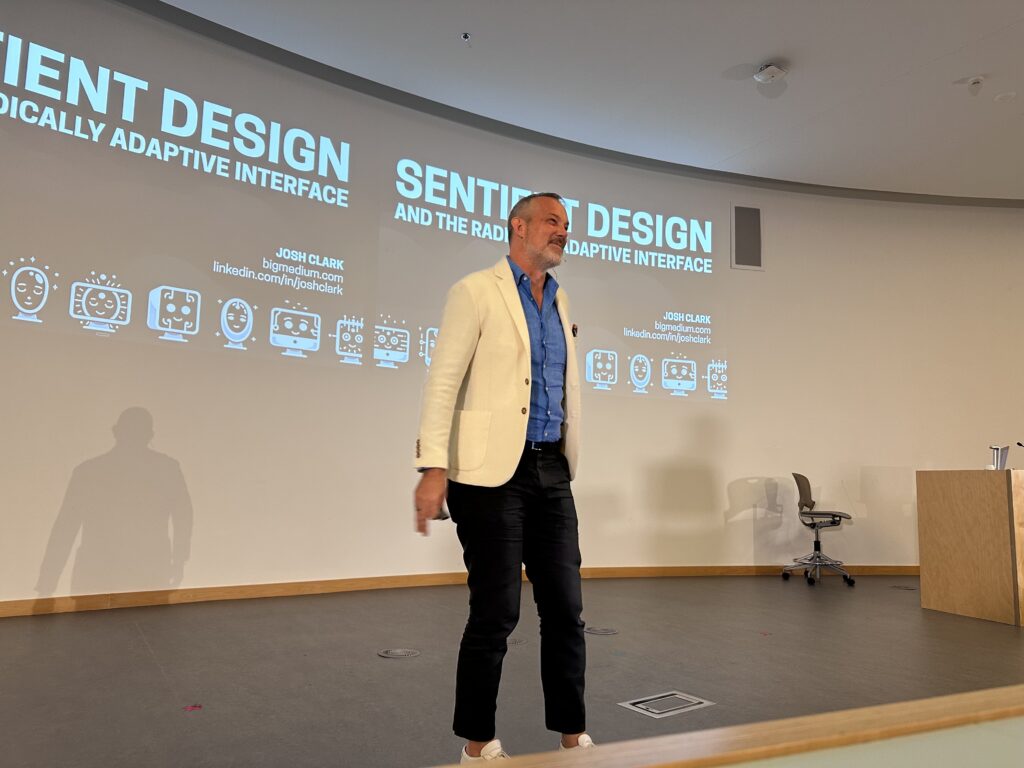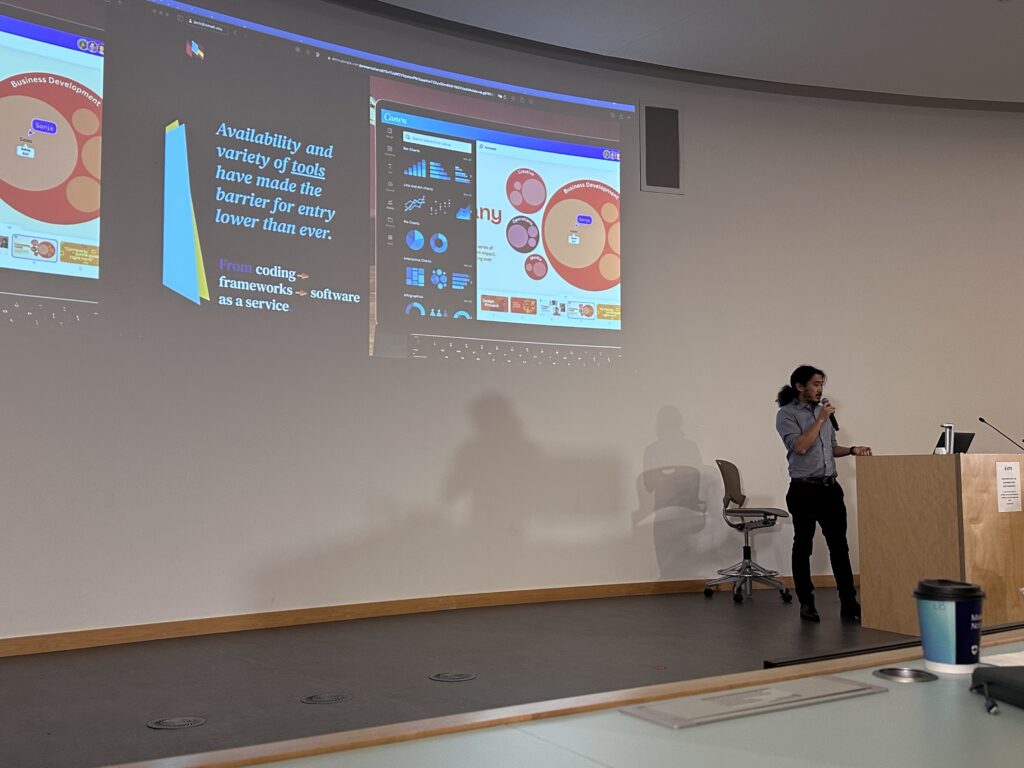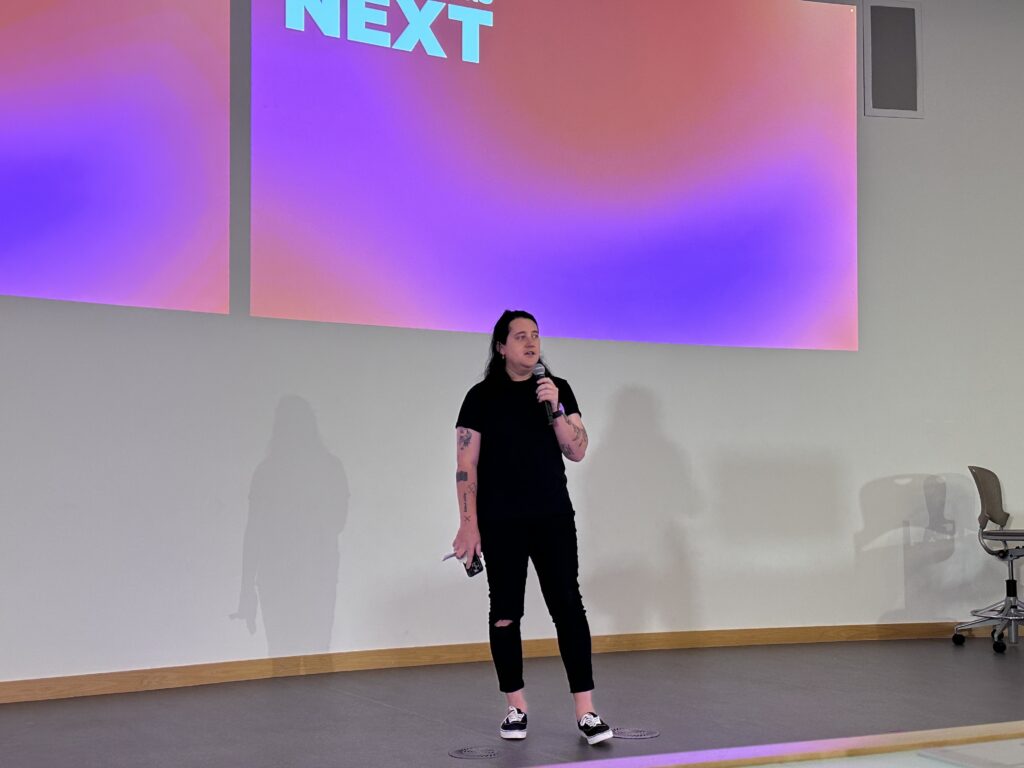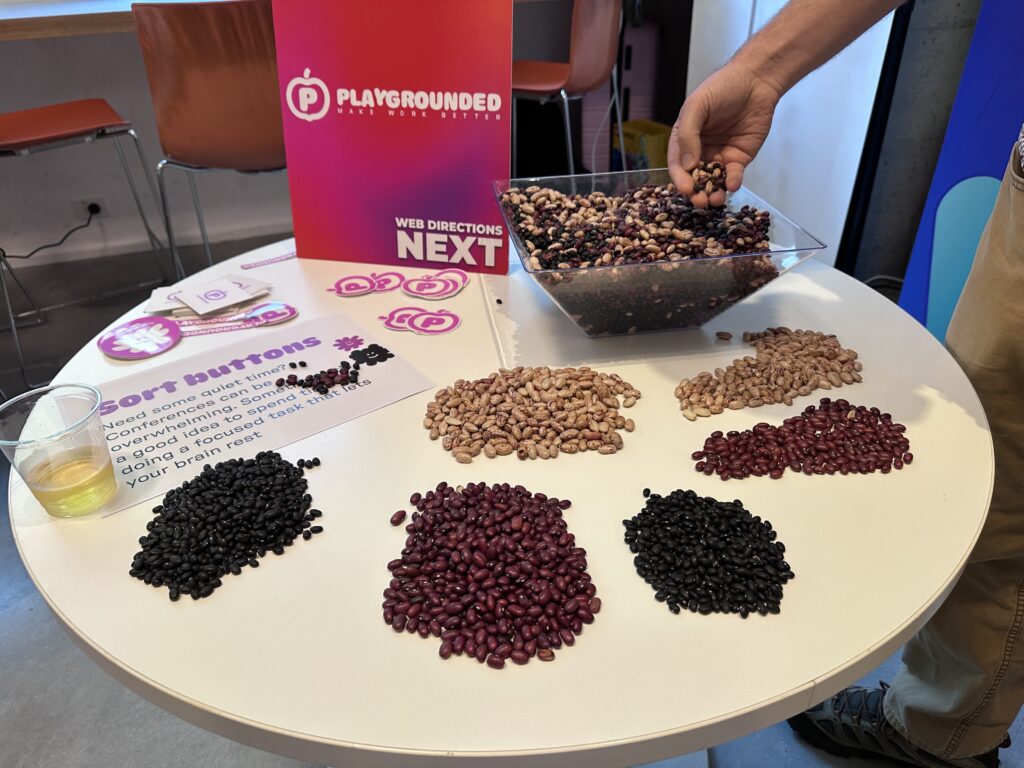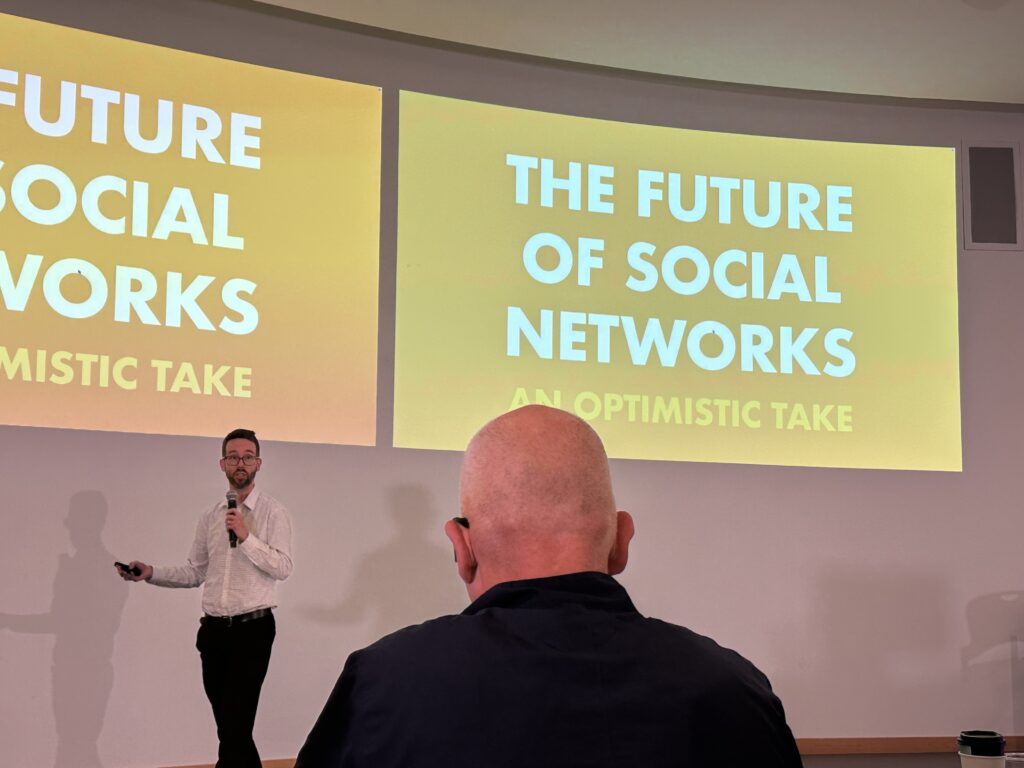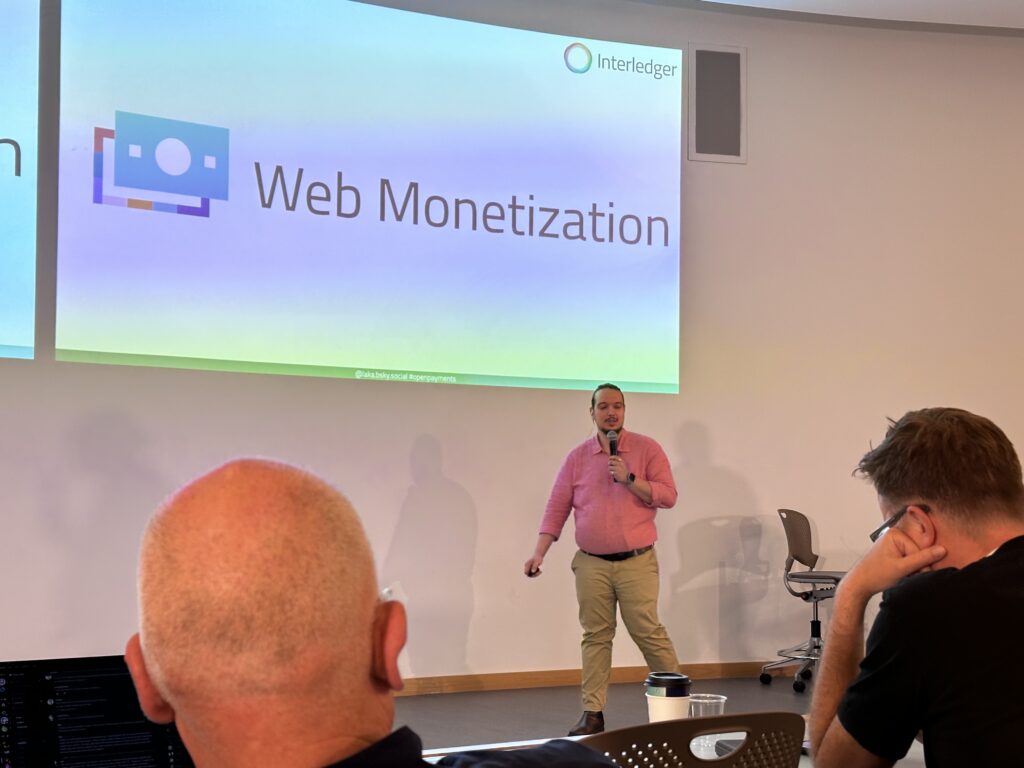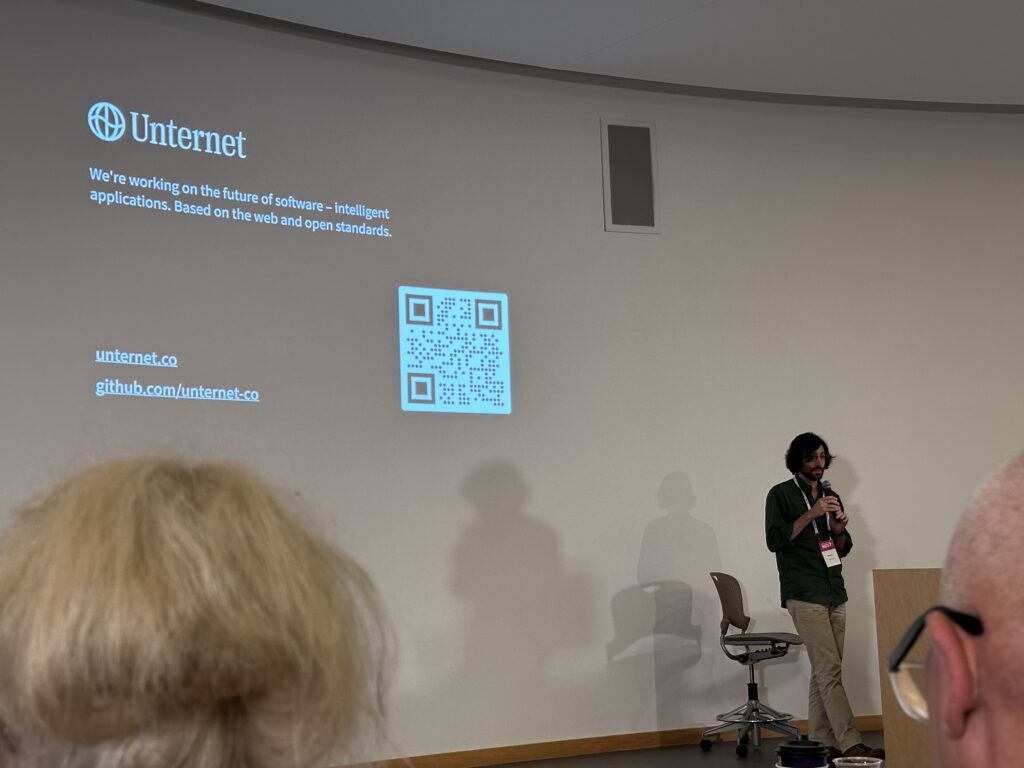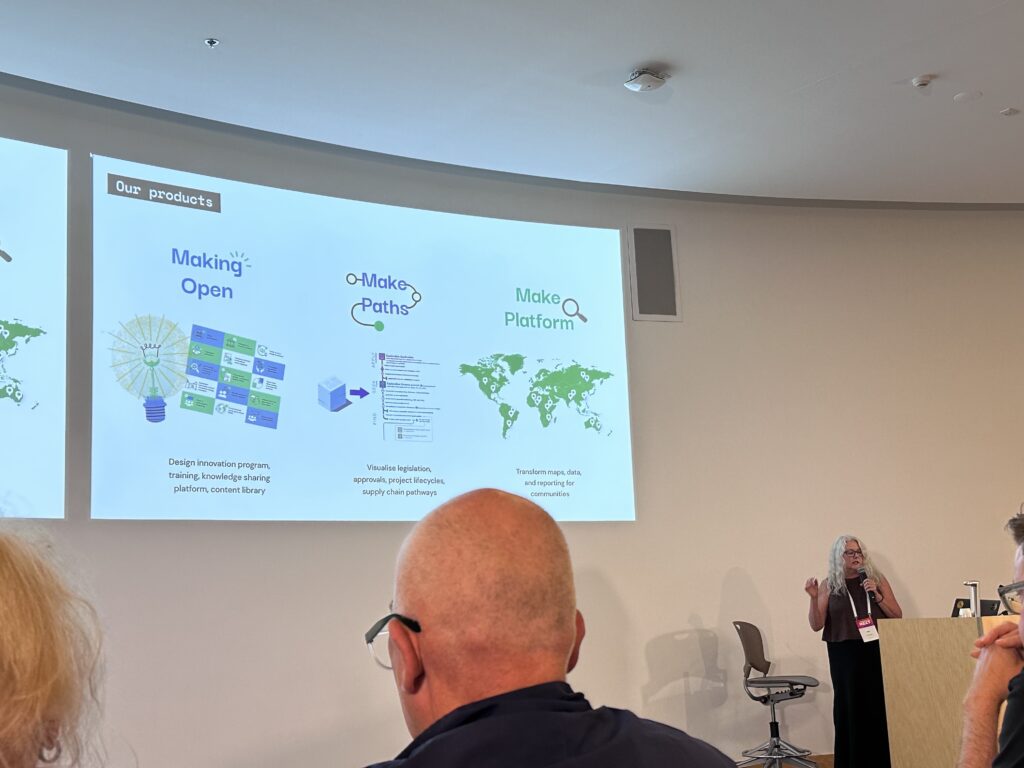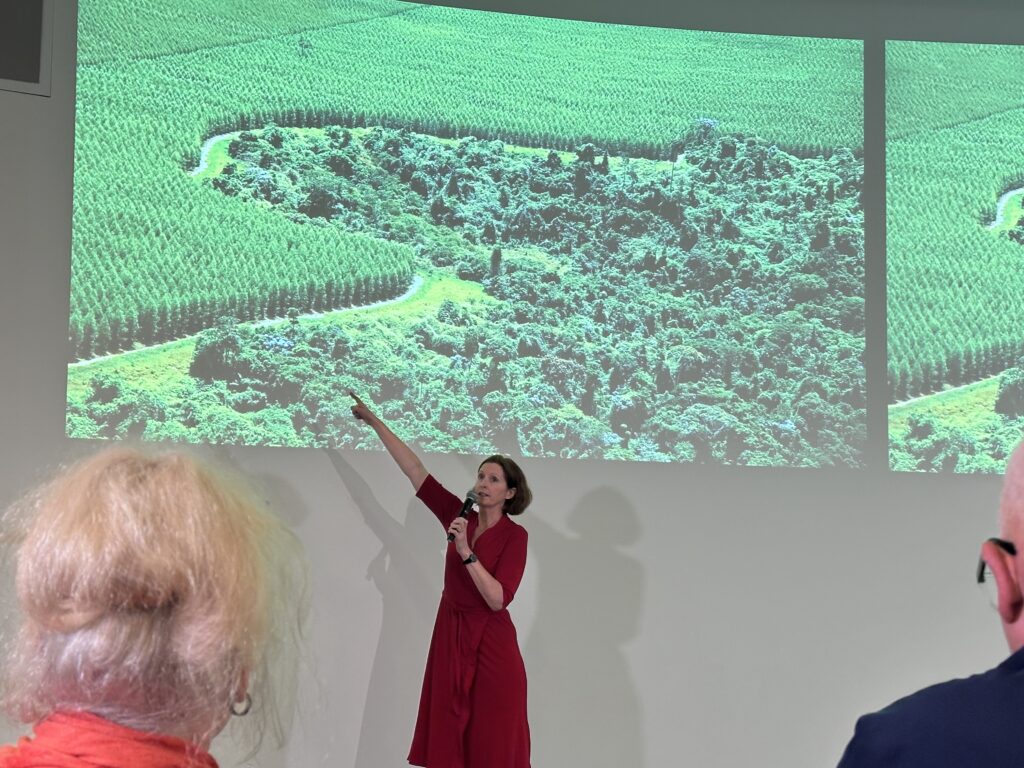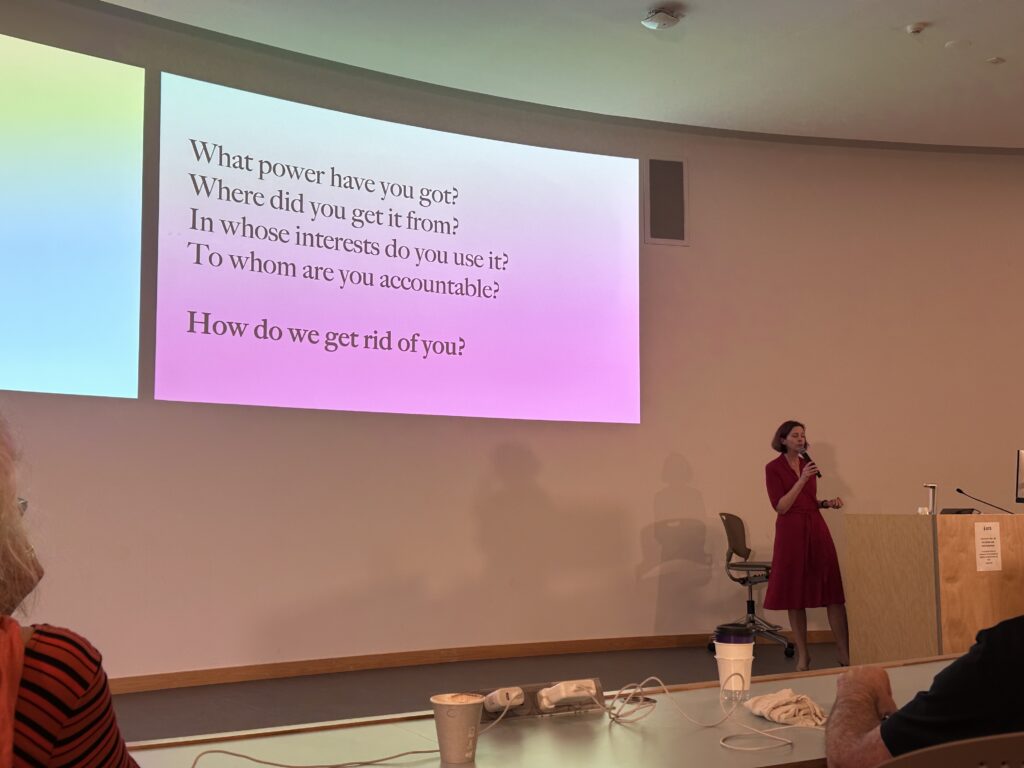Rodd and I were very excited to attend Web Directions Next 2024 last week. Web Directions have been running top-notch tech events in Sydney for decades (I’ve been a speaker for a couple of them), and this conference promised to focus on the future of product, design, and strategy. I wasn’t sure quite what to expect, and I took notes throughout the day to illustrate the breadth of topics covered.
John Allsopp (founder of Web Directions) kicked things off in the morning with an Acknowledgement of Country and a rather rueful note about the recent US election. It would turn out to be a common theme for the day, but John said he hoped that the day would still inspire us to hope (and work) for the best. John also mentioned that he’d created a Bluesky Starter Pack of all the speakers for the event, which seemed like a great idea that I hope will get traction with other events.
The first speaker of the day was Nicholas Gruen, a prominent Australian economist and former government advisor. (Unfortunately he’s the only speaker I didn’t get a photo of. Apologies, Nicholas!) He’s been working on a new series of videos about important topics like democracy, self-interest, and leadership, and he returned several times throughout the day to show us a selection of them. His point was that we need better institutions to help bring out “our better angels,” whether those institutions are governments or social media companies. He drew comparisons to Ancient Greece and Rome, and one point that really stuck with me is that the best leaders are often those reluctant to lead. We need a true meritocracy rather than a “shoutocracy” to counter the inherent hierarchical and competitive nature of elections. He also brought up a few examples of Citizens’ Assemblies, which drew a lot of discussion from the audience. He’s a fascinating guy, and I’m hoping the videos will eventually be shared online.
Next up were Martin Tomitsch and Steve Baty, talking about “life-centred design.” They showed the flaws in the traditional approach to user-centred design, which results in “innovation” like crash test and CPR dummies that don’t represent women, the worsening environmental crisis, and injustice. Life-centred design, by contrast, adds in environmental and ethical responsibilities. They also talked about how governments could help change corporations’ incentives in these areas, through tax rates, regulation, and pressure to report on environmental progress. You can read more about their nine principles of life-centred design on their website here.
The next speaker was Mary Nolan, talking about nudge theory, which seeks to influence the behaviour of groups through “choice architecture.” Rather than forcing people to do the right thing, you subtly encourage them. Mary walked us through the basics of the theory, and I thought about some of the ways I’d encountered nudges in my own life recently: our electricity bill has a section comparing our energy usage to our neighbours, and how strongly I was encouraged to “make a plan to vote” in the lead-up to the US election. Mary pointed out criticism of the approach though, like the fact that it focuses on individuals rather than systems. “All the nudges in the world,” Mary said, “can’t get someone to recycle if there’s no recycling infrastructure.” Nudges have to be part of a solution, not the entire solution.
Our final speaker before the morning tea break was my friend and former neighbour Mark Pesce. Mark’s talk was brief but energetic, and it was one of the ones that resonated with me the most over the course of the day. Mark talked about human longevity, which I know is an interest of his, and how studies have shown that the three keys to remaining healthy as we age are to be active, connected, and contributing to society. I couldn’t help but reflect on Rodd’s and my situation now that we’ve left full-time employment. We have to very consciously make an effort to get out and engage with the world, rather than cocoon ourselves at home in our little bubble. Attending events like Web Directions felt like a great step in the right direction!
After the tea break and another video from Nicholas, the next speaker was Josh Clark talking about “sentient design.” Josh’s point was that AI needs to be woven into user experiences rather than just bolted on, and he gave a lot of examples that aren’t just another chatbot. One was the “Pinocchio” design pattern, where an application turns your lo-fi artefacts into working prototypes. “Machine intelligence is our new design material,” he said, and reminded us that “typing prompts is not the UI of the future.” His talk immediately reminded me of the Fantasy Game from Ender’s Game, which began to adapt itself to Ender and eventually became the sentient Jane.
The next speaker was Jack Zhao talking about data visualisation. Jack walked us through the history of data visualising, reminding us that every two years, the volume of data in the world doubles. He also took us on the journey of his own design consultancy, and the skills you need as a leader to weather the ups and downs in the industry. Jack’s advice to the audience was to stop designing for the “average” person, to recruit teams of communicators rather than focusing on just technicians, and to “materialise all your ideas with new tech.” I was surprised to the degree which Figma had replaced a lot of tools in the designer’s arsenal these days.
The next lighting talk was from Joan Westenberg, who presented without slides and immediately started dropping truth bombs on the audience. The Democrats lost, Joan said, because they campaigned on facts, while the Republicans campaigned with stories. “Stories,” she said, “are more exciting.” Stories are the oldest tech we have as humans, and you can’t fight stories with facts. Joan didn’t have any conclusions to this conundrum, but she got everyone thinking.
One of the charming parts of this event was the activations provided by my friends at Playgrounded out in the expo area. Stefan and Georgina had provided a number of ways for attendees to relax, meet new people, and learn by engaging different parts of their brain. They had Lego, Play-Doh, video games, and Stefan even dressed as a giant teddy bear at one point. I also really appreciated this “bean sorting activity,” and it appears I wasn’t the only one. (Playgrounded focus on helping leaders with growing, hybrid, and remote organisations to connect better with their groups. You should definitely check them out.)
The next speaker was Jon Bradshaw, talking about something both Rodd and I have worked with in our careers: data-driven advertising. Marketing budgets are down, Jon said, but spending on MarTech is up. People are trying to make their money go further, but data-driven marketing is expensive and complex. Jon was realistic about the challenges and drawbacks of trying to use data to target your advertising, pointing out that data quality is often very poor and the sales it drives are incremental (ie. the person would’ve bought anyway). The best approach, Jon suggested, was still the traditional one: “fishing where the fish are,” and making sure that marketers fit their message to the particular medium.
The next talk was also one of my favourites — Jon Bell talking about the future of social networks. And Jon should know, having previously worked at Twitter. Jon demonstrated a number of solutions to the problems of social media, and the best part, he emphasised repeatedly, was that they were all possible today. These aren’t theoretical concepts; they’re practical ways for filtering trolls, enabling better search, and improving our algorithms. It was really fascinating to connect this talk with many of the ongoing discussions I’ve seen lately on Bluesky and Mastodon about ways to verify identity on social networks, and methods to filter out noise and bad actors. (This talk was also delivered on the same day the Australian government banned under-16s from social media. Timely.)
Next up was Alex Lakatos, who gave a fascinating talk about Interledger. Interledger, he emphasised, is not a crypto project. (Phew!) Instead it’s about developing a new standard for sending payments between banks overseas. As someone with money on three continents, this talk was definitely relevant to my interests! Alex pointed out that only around 70 countries in the world have connected banks, and banking software is really old and slow. This is why it takes so long to move money around. Alex talked about how the group mapped the principles of Interledger onto the founding principles of the Internet, and how they approached some of the problems around packet loss and different currencies. One intriguing effect of the Interledger protocol is that you can “stream” payment, meaning you could pay websites for the amount of time you spent on their site rather than having to watch ads! The biggest bottleneck to uptake of Interledger’s technology is regulators and lawyers. (The project is on Github if you want to contribute.)
Next we had a very quick lightning talk from Rupert Manfredi, the CEO of a new project called Unternet. Rupert talked about how traditional point-and-click applications built for humans are dumb and unconnected, which means AI agents aren’t really able to take action on your behalf right now. Unternet are trying to create a new kind of software called Web Applets that are designed for human-AI collaboration. I need to dig into this a bit more, as it sounded like the process of defining an Applet is basically just defining an API. It would have been good to hear more about why this is different from traditional APIs, but unfortunately he didn’t have much time. (The challenge with a conference stuffed with amazing speakers and that prompts so much discussion is that by the end of the day, you’ve run far over the planned schedule!)
We also had a very, very quick introduction to Mel Flanagan from Nook Studios. In particular, Mel talked about some of the projects they’ve worked on for the government to make data and information more open and available to the community. I was really interested to hear about Common Ground, a web service that helped people access information about mining activities in their area.
The final speaker for the event was Maria Farrell, talking about. “rewilding the Internet.” I absolutely loved this session and related to it strongly. It brought together a lot of the strands from the other talks, but she also challenged a few of them as well. Maria started off talking about Prussian forestry, and how the leaders chopped down old grown forests and replaced them with organised monocultures of trees grown for timber. This brought great profits for a short time, but then collapsed due to lack of resilience and diversity. The analogy to tech is pretty clear. Maria then pointed out that we have global duopolies across pretty much the entire tech stack, and you can see the effects with things like Crowdstrike. Maria shared with us her “OFG Theory of Internet Governance,” which is that there’s always One Fucking Guy extracting data and capital and exerting control over everyone else. “Big Tech loves autocrats and dictators,” she pointed out. Her talk was a call-to-arms to help disassemble these silos. She shared some questions that should be put to leaders, and pointed out that if they can’t answer “How do we get rid of you?”, then we don’t live in a democratic system.
So ultimately “rewilding the Internet” is about bringing back the Internet of weirdness and the Cosy Web, and getting rid of the OFGs. How do we do it? First, the government needs to use the coercive power of the state. They need to knock down monopolies and mandate interoperability. The way we get involved, she said, is to give our politicians hell. We can also do our own part to rewild the Internet, by using services outside the monoculture silos. She listed a number of services, and I made a mental note to investigate moving my email service away from Gmail. We can also choose how we pay the costs of data infrastructure and journalism, rather than giving up our data and privacy to OFG. The goal of all of this, she said, is to regain the feeling of being connected, of being part of something bigger. 🩷 Like I said, I really resonated with Maria’s talk, and it’s very much in line with my recent attempt to Get Back to Blogging and to start centralising my data onto my own platform rather than scatter it across silos.
Thanks again to John and the Web Directions team for putting on such an excellent event. It was lovely to meet all the speakers and to learn about so many new things. I’m going to try to hold onto this feeling of optimism and engagement as we head into 2025. Things are going to suck, but together we can put up a strong resistance and try to build a better future.


